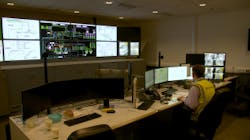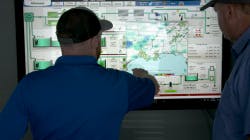With the introduction of new technology, cloud computing and mobility, the digital transformation of the industrial sector has begun. We know this. Applications for smartphones and tablets are entering the industrial space at an increasing rate—changing the way we acquire, view, store, analyze and act on data and information.
Despite the presence of these new technologies, most organizations still use clipboards
Inductive Automation's Travis Cox
and paper to gather data and information. The vast majority of this data gets stranded in the field in silos or islands. Furthermore, industrial applications have historically been closed and proprietary—limiting users in functionality, connectivity and licensing. That presents real challenges when you’re trying to connect an enterprise and get data to everyone who needs it.
What does it take for an industrial system to really be future-proof? It means having confidence in your ability to expand, scale and extend your system rapidly, affordably and whenever necessary, leveraging modern technology and open standards. And that level of adaptability calls for much more than a traditional HMI/SCADA product; it requires a full industrial-application platform.
I am increasingly seeing companies embrace modern industrial-application platforms and technology, creating innovative and modern industrial systems across industries. This was evident in the Discover Gallery at our 2019 Ignition Community Conference, where customers explored the advantages of a modern, expandable industrial platform, connectivity to multiple sources of data, edge computing, MQTT, the cloud and mobility.
Consider some cool new projects
Let’s start in Ireland—with the Dublin Airport. This international airport worked with Brock Solutions to replace its baggage-handling systems in Terminal 2. Dublin was tired of the
The system in use at the Dublin Airport
client-based licensing it was receiving from its legacy SCADA provider. The airport required a configurable off-the-shelf solution that allows it to meet its future expansion requirements without additional licensing costs. The new system connects to 14 devices, has some 100,000 tags, and provides data to whomever needs it. And that’s just the start; the airport is looking at solving problems throughout the entire airport now that it has a platform it can grow with. (Dive deeper into this project and watch a video here.)
The demand for data is increasing. We know this. Customers want access to more data in order to make better decisions and increase profits. It’s not just the need for plant-floor data; data from other systems and external sources are also required. In Arkansas, the City of Decatur is experiencing this firsthand. The city worked with H20 Innovation and Automation Station to install the first membrane-bioreactor wastewater treatment plant in the state. A big concern was the increase in energy consumption most membrane
Analyzing weather data in Decatur
bioreactors have. Using the new SCADA system and connecting to all of the data, real-time energy consumption was tracked, adjustments were made, and reports demonstrated the savings. Also, the city was able to bring real-time weather data and a live radar map into the historian. Now, Decatur can view historical weather events and correlate that to process data to trend how its plant reacts to large storms.
Six-month success
In some cases, in can be difficult to get access to the operational data due to proprietary polling protocols, low bandwidth networks, or remote facilities with no connectivity. ARB Midstream, providing crude oil and gas liquids, acquired a new pipeline system with 36 RTUs and central gathering locations. As part of the purchase agreement, ARB was required to begin operating the pipeline in six months. Also, a new SCADA system was needed in four months. Challenged with this aggressive schedule, ARB installed a new system with a standardized network infrastructure and a centrally manageable and scalable SCADA platform.
The project was made possible through edge computing, cellular SD-WAN, and the use of MQTT. 97 edge gateways communicated to 145 devices pushing the polling to the edge of the network. All data was reported by exception to a central server using MQTT, reducing the bandwidth needed and providing access to more data at faster rates. The new system and infrastructure will enable ARB to quickly acquire assets in the future and integrate them into a unified SCADA system.
Edge computing is not just for distributing polling and communication to field devices, of course. It can also provide local compute engines for complex calculations. Streamline Innovations operates natural-gas treating units in south and west Texas that convert dangerous hydrogen sulfide (H2S) into fertilizer-grade sulfur. H2S is an extremely toxic, explosive chemical found in most natural gas. Streamline’s small units remove H2S from individual wells, typically in remote locations for which constant human operation would be too costly for commercial operation. Simple maintenance issues could require travel to the site and take hours.
Streamline’s first approach with these units employed an automation platform written on a standard PLC, but this did not enable complex calculations to provide model-based controls (and therefore semi-autonomous operation), nor remote control of the unit should a problem arise. Instead, Streamline turned to edge computing to run a number of Python scripts that allow complex calculations—such as fast Fourier transforms on pump vibration and weather forecasts downloaded from the National Weather Service to determine optimal operating temperature—something that would seem impossible with a PLC. Furthermore, auto-notifications of alerts are sent via Twilio to operators and operations engineers when issues arise.
Into the cloud
Along with edge computing, more and more companies are leveraging the cloud, which offers a tremendous amount of scalability, especially for historical data, without the usual IT headaches of managing and scaling server hardware infrastructure. The team at ESM Australia developed a scalable asset-management system to monitor performance and meet service requirements for a client with systems deployed all over Australia. Using a mix of MQTT and legacy FTP-enabled gateways in the field, ESM harnessed the scalability of our Ignition tool in the AWS cloud to provide a platform that allowed the client to add, remove, and manage connected assets through a simple interface. Operations, dispatchers, and maintenance teams have absolute real-time visibility of fixed and mobile assets no matter where they are. Also, historical data can be stored long-term, allowing for future analytics and analysis.
Access to data is vital. We know this. The use of smartphones and tablets is increasing. In fact, mobile devices have surpassed desktops for getting online and finding information. We’re seeing this paradigm shift in the industrial space. San Bernardino County in southern California was looking for its next-generation visualization-and-control system for its landfills. Existing equipment was older and in need of upgrade—it did not have an easy-to-use HMI or data visualization.
The mandate was clear: there is a need for a flexible architecture that allows visualization natively in HTML 5 in order to leverage any modern device with a browser. Using a hub-and-spoke model with an edge gateway onsite and our Ignition Perspective in the cloud, Corso Systems and SCS Engineers were able to offer a complete enterprise solution for the county. SCS uses aerial data to compose topographic mapping, 2D images, 3D renderings, GIS, thermal, near-infrared (NIR), and methane leak detection for various waste facilities. After flying over the San Timoteo Landfill, uploading the imagery, and mapping the facility, SCS and Corso were able to embed both the 2D images and 3D rendering into Ignition Perspective. This allowed users to get access to data using any modern device from anywhere. Additionally, the team was able to take those rendered images and apply them into a Microsoft HoloLens VR headset, which enables decision-makers at San Bernardino County to “walk the site” from their offices.
Obviously, digital transformation is possible. And there are easy steps to follow in order to take advantage of the new technology. Fully embracing new technology will allow operations to take their applications to the next level and provide more access to users in the organization.
Travis Cox is co-director of sales engineering at Inductive Automation.






